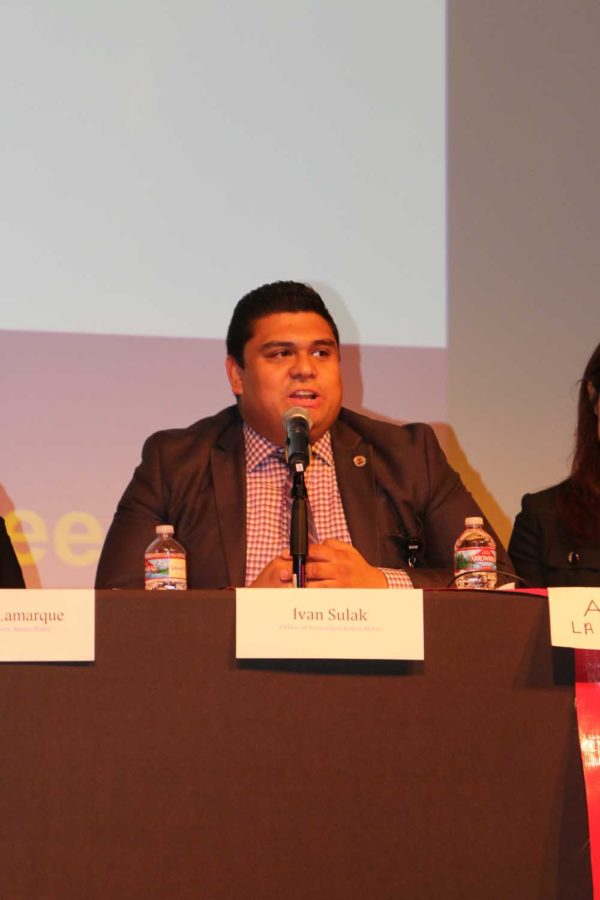Panel addresses homelessness in South Bay

Ivan Sulic, a field deputy for L.A. County Supervisor Janice Hahn, was one of several panelists at a League of Women Voters panel on homelessness in the South Bay Monday night. Photo
Residents attending a panel discussion on homelessness in the South Bay Monday evening didn’t have to look far for proof that progress was being made in addressing the problem: one of the panelists used to be homeless himself.
Ivan Sulic, a field deputy for L.A. County Supervisor Janice Hahn, was one of seven panelists at a discussion sponsored by the League of Women Voters, and he shared his story of being homeless for part of his youth in San Pedro, before the audience in Hermosa’s Community Theater. He and his mother, he recounted, were able to obtain temporary housing, then financial assistance, and eventually a home of their own.
Sulic’s case embodies the changing look of homelessness in the county, with more families and young people than in the past. Although the number of people experiencing homelessness declined slightly last year, it has surged in Southern California in the last decade, with nearly 53,000 in Los Angeles County. Numbers for this year were tallied this week as volunteers fanned out across the county, including the Beach Cities, and will be released in May.
Panelists presented a panoply of ways that the county was addressing homelessness, but the evening underscored the growing “housing first” consensus. By far the most cost-effective remedy, they said, is to prevent someone from going homeless in the first place, something increasingly difficult amid climbing rents in the region. For those who do end up on the streets, experts say that things such as finding and holding a job are far easier to accomplish once a person has a stable housing situation, instead of thinking of housing as a reward for stabilizing the rest of a life.
Looking at a data from last year’s homeless count that showed 625 homeless people in the Beach Cities, El Segundo, Inglewood and Hawthorne, Shari Weaver, director of the Coordinated Entry System with Harbor Interfaith, said: “What this tells me is, we need 625 housing interventions.”
In Hahn’s supervisorial district, which includes the South Bay, the county was funding “brick and mortar projects” in Long Beach, Downey, and Santa Fe Springs. Many of these units will be targeted at homeless veterans or youth.
“The end to homelessness is putting people in housing,” Sulic said.
There has been more success finding short-term housing for homeless people recently than in the past, due partly to more resources being committed. Ashlee Oh, who heads the homeless initiative in the office of the county CEO, said that between July 2017 and September 2018, more than 18,000 people entered crisis, bridge or interim housing paid for in whole or in part through Measure H, a countywide sales tax passed by voters in 2017.
But the distribution of housing options, both permanent and temporary, does not reflect the scattering of homeless people in the region. This is especially true in the South Bay. County-wide, about three-fourths of homeless people are unsheltered, “but in the Beach Cities it’s almost everyone,” Oh said.
This is due at least in part to political opposition from residents to providing housing locally.
Over the last year, residents in all three Beach Cities have pushed for stronger enforcement measures against homeless people. Several of the evening’s questions for panelists involved quality of life issues associated with churches in Redondo Beach that hold regular feedings of the homeless, while in Hermosa, alleged crimes committed by homeless people sparked a social media frenzy and prompted a community meeting about homelessness and public safety.
In Manhattan Beach, the City Council approved an “anti-camping” ordinance in September, just days after the Ninth Circuit Court of Appeals declared a similar ordinance, from Boise, Idaho, unconstitutional. And while city staff have defended the law’s legality, police demurred Monday on whether it was actually helpful in addressing homelessness.
MBPD Lt. Jason Knickerbocker said Monday that it was “to be determined” whether the ordinance was helpful or harmful. He said that police officers don’t write the laws, and allowed that every community will have different priorities in addressing the issue. But, alluding to what he described as a “cultural shift” among local police departments in addressing homelessness in recent years, officers recognize that homelessness is not a problem that cities can enforce their way out of.
Gaps in the social safety net mean that police officers are often the “first responders” helping the homeless. A grant from the county has placed a clinician from the county Department of Mental Health on a rotation with the three local police departments four days a week. Officers say the program has led to huge improvements, and the loudest applause of the night came with the announcement of possible additional funds from the county to add more days for a clinician. This helps them build up a rapport with people that they often encounter on the street, Knickerbocker said, something officers are hesitant to sacrifice over violations of ordinances such as bans on camping or smoking.
“With the enforcement aspect, whatever action you take, you have to make sure that it doesn’t damage the rapport you have built up,” Knickerbocker said.

